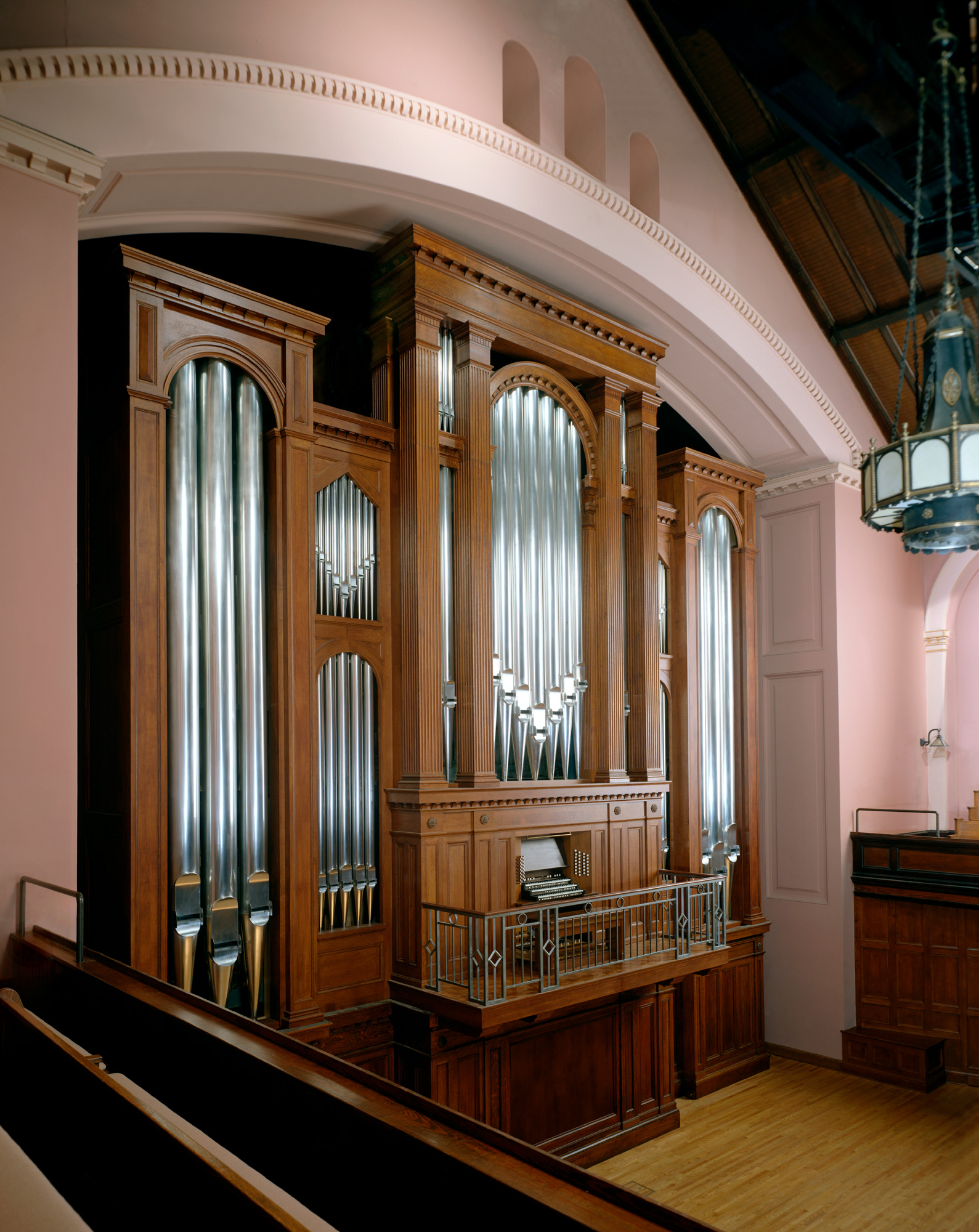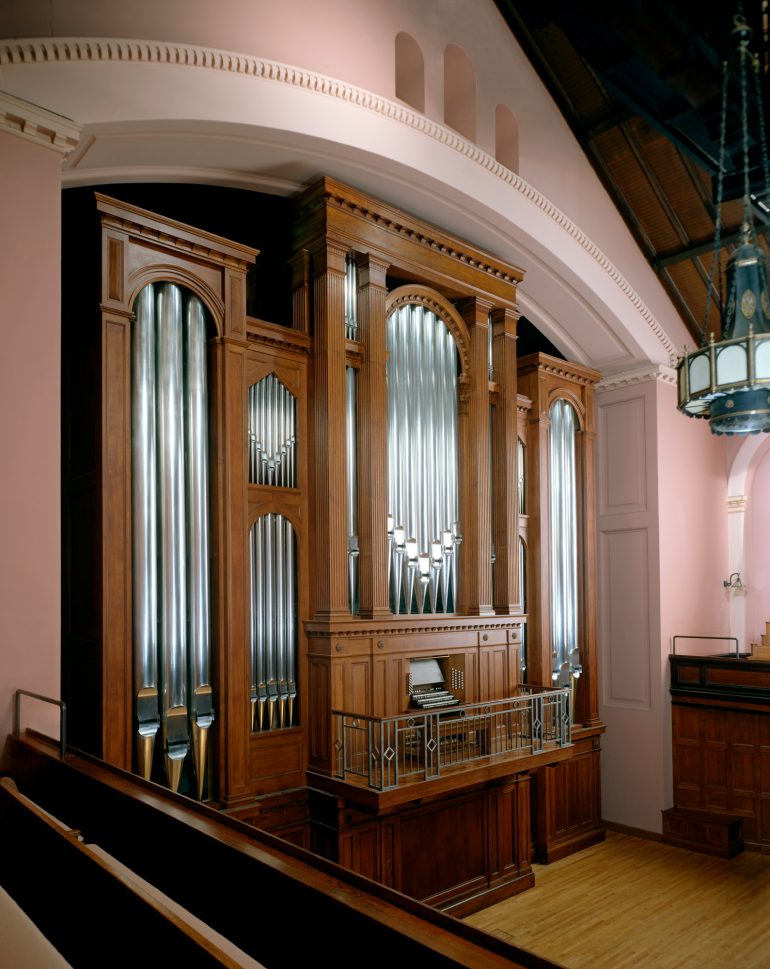
- phone: 978.283.1909
- email: cbfisk@cbfisk.com
Opus 116
Finney Chapel, Oberlin College
Oberlin, OH
Ranks: 75Independent Voices: 57
Pipes: 3951
Created: 2001
Internationally recognized as one of the leading centers of organ instruction in America, the Oberlin Conservatory of Music is the home of an impressive collection of organs. At the heart of that collection is Opus 116, a three-manual, sixty-stop organ of seventy-eight ranks. An instrument of great power and subtlety, Opus 116 was designed to bring to life the music of the French romantic composers.
The work of French master organbuilder Aristide Cavaillé-Coll, especially his late symphonic organs such as those in the cathedrals of Rouen and Toulouse, served as a tonal point of departure at Oberlin. The organ’s three manual divisions each contain 8′ foundation stops (the fonds d’huit), batteries of reeds, and mutations necessary for the authoritative performance of French romantic and modern organ literature. The independent pedal division provides the gravitas necessary for this repertoire with three 32′ voices and powerful reeds.
The Grand Orgue division is designed after Cavaillé-Coll with separate wind boxes and pallets for the reeds and flues. A mechanical ventil pedal controls the activation of the reeds for this division. The key action of the organ is direct mechanical. A Kowalyshyn Servopneumatic Lever assists the Grand Orgue, and all divisions coupled to it. Opus 116 can be controlled in two operational modes: français or American. In American mode the stop action is controlled by pistons with a modern solid-state multiple memory level capture system with sequencer. In mode français the pistons are disabled and the French system of pédales de combinaison controls flues, reeds, and couplers.
The first solo recital during the organ’s inaugural year in 2001 was played by Daniel Roth, organist titulaire of the Cavaillé-Coll organ at the church of St. Sulpice in Paris.

Grand Orgue, Manual I
Montre 16ʹ
Bourdon 16ʹ
Montre 8ʹ
Gambe 8ʹ
Flûte harmonique 8ʹ
Bourdon 8ʹ
Prestant 4ʹ
Octave 4ʹ
Doublette 2ʹ
Dessus de Cornet V
Grande Fourniture II
Petite Fourniture V‐VIII
Bombarde 16ʹ
Trompette 8ʹ
Clairon 4ʹ
Positif, Manual II, enclosed
Quintaton 16ʹ
Principal 8ʹ
Salicional 8ʹ
Unda maris 8ʹ
Cor de Nuit 8ʹ
Prestant 4ʹ
Flûte douce 4ʹ
Nasard 2 2/3ʹ
Doublette 2ʹ
Tierce 1 3/5ʹ
Larigot 1 1/3ʹ
Piccolo 1ʹ
Plein jeu IV
Cor Anglais 16ʹ
Trompette 8ʹ
Clarinette 8ʹ
Récit, Manual III, enclosed
Bourdon 16ʹ
Diapason 8ʹ
Viole de gambe 8ʹ
Voix céleste 8ʹ
Flûte traversière 8ʹ
Bourdon 8ʹ
Dulciane 4ʹ
Flûte octaviante 4ʹ
Octavin 2ʹ
Plein jeu III‐IV
Basson 16ʹ
Trompette 8ʹ
Basson‐Hautbois 8ʹ
Voix humaine 8ʹ
Clairon 4ʹ
Pédale, 32 notes
Montre 32ʹ (from 16ʹ)
Bourdon 32ʹ
Contrebasse 16ʹ
Montre 16ʹ (G.O.)
Sousbasse 16ʹ (32ʹ)
Violonbasse 16ʹ
Flûte 8ʹ
Violoncelle 8ʹ
Bourdon 8ʹ
Flûte 4ʹ
Contre Bombarde 32ʹ
Bombarde 16ʹ
Trompette 8ʹ
Clairon 4ʹ
Pédales de Combinaison
Hook down pedals in Mode français
Tirasse Grand Orgue
Tirasse Positif
Tirasse Récit
Copula Positif/Grand Orgue
Copula Récit/Grand Orgue
Copula Récit/Positif
Grand Orgue sur la machine
Octaves graves Grand Orgue
Anches Pédale
Anches Grand Orgue
Anches Positif
Anches Récit
Trémolo Récit
Trémolo Positif
Effet dʹorage
Couplers:
Available in American Mode
Grand Orgue/Pédale
Positif/Pédale
Récit/Pédale
Positif/Grand Orgue
Récit/Grand Orgue
Octaves graves GO
Récit/Positif
Récit Trémolo
Positif Trémolo
American Mode includes a modern multi‐level combination action accessed with thumb pistons and a
forward and reversing sequencer with both thumb pistons and pedals.
Accessories:
Balanced Expression Pedals
Key action: Direct mechanical (tracker)
Kowalyshyn Servo‐pneumatic Lever
Stop action: Electric Solenoid
Casework: A single cabinet of oak, incorporating portions of the original organ case, designed by Cass Gilbert, architect of Finney Chapel.
